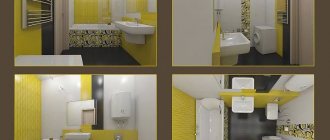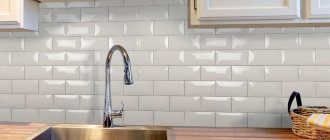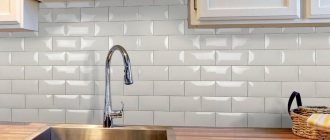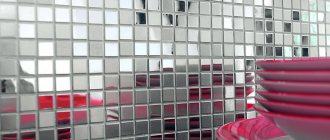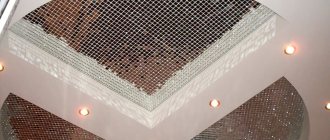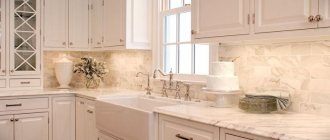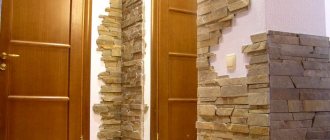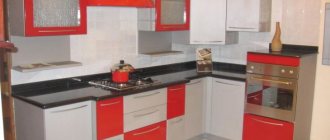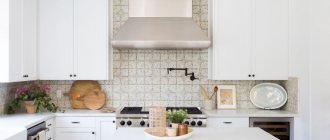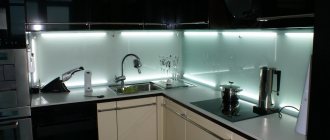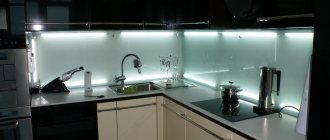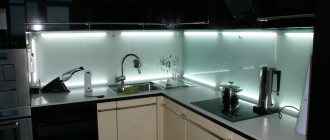An apron in the kitchen is an integral part of the interior. Regardless of the size of the room, an apron can become a bright accent with a minimal investment of money. The most successful solution is to use materials such as tiles and glass. But in order to appreciate all the advantages of ceramic tiles, let’s consider the advantages and disadvantages of all types of materials that can be used for a backsplash.
Please note that for the harmony of space it is necessary to respect the proportions of the kitchen itself and the density of the objects located in it. That is, the smaller the size of the kitchen, the more kitchen items, and the more minimalist the apron should look.
Kitchen apron standards
The height of the apron, or as it is also called the width, according to the standard varies from 50 to 60 cm. Why is there no specific number? This is simply explained. This run-up is influenced by the height of the person, as well as the type of slab. When using a ceramic model with a standard size of 30 cm, the standard for the apron will be 60+0.1 cm (two 30 cm tiles and a seam between them). But it's true, it's a classic. With today's variety of sizes of ceramic tiles, the height of the apron can be different. Everything is selected individually.
The height is also affected by such a nuance as the hood. If the model is built-in, then this does not affect anything. But if it is not built-in, then the apron will be higher (due to the fact that the hood is installed at a distance of 70-80 cm from the stove). This extra distance must be taken into account, as it entails additional material costs.
Another important point that must be remembered and taken into account when installing the apron is that the height of the covering must be 2-3 cm so that it goes directly under the cabinets.
In order for the apron to fit organically into the interior, it is necessary to install it around the entire perimeter of the kitchen, and not be limited to areas above the sink and stove. Yes, these are the most problematic places in the kitchen, but the cooking area also cannot boast of cleanliness. The savings here are questionable.
A good option for a corner sink would be to install an apron completely around it, that is, taking into account the perpendicular wall.
Choice of color and design solution
The color scheme is not a determining factor, as it does not affect its practicality. The color of the apron depends only on your preference and kitchen design. And dirt, of which there is plenty in the kitchen, will be visible in any case if you do not put things in order in a timely manner.
But what you really need to pay attention to is the texture of the selected material. It is better to give preference to a non-uniform solution, then the spots will not be so noticeable. Imitation of marble, stone, wood is suitable. But on a uniform texture, even a slight speck will be noticeable.
As for the shade, it is better to prefer a light option than a dark one. Salt stains after water will not be so visible. But it is better to use gray grout for the joints, so the coating will look more attractive.
If you are attracted to bright colors, then make sure that the kitchen apron matches the textiles. These are two fundamental ones that will determine what the kitchen looks like as a whole.
If you prefer a monochrome direction, then it would not be superfluous to dilute such an interior with a rich palette, for example, all shades of green. In green it is easy to choose all kinds of kitchen accessories in the form of towels and potholders.
And if your kitchen is small, then without hesitation, only plain options without any unnecessary details.
Kitchen apron made of ceramic tiles
By choosing ceramic tiles, you will really find the best option, since the choice is huge: any color, texture, size. The tile looks very cool under lighting, it has no equal here. The only drawback is the grout for the joints, but with the right choice, this drawback can be minimized.
When calculating the square footage of the apron, do not count on large numbers, even if the kitchen is huge. Therefore, you should not cut your budget, but take advantage of the opportunity to purchase the tiles you dream of, despite the price.
Ceramic tiles with imitation marble or wood will always look cool. But the main thing is that it is an imitation of not only the pattern, but also the texture.
A white boar tile would look like a win-win option. He has firmly taken his leading position and is not going to give it up. And all thanks to the fact that such tiles are perfect for both classic and modern styles. A white boar will always look relevant and advantageous, as it is a time-tested option.
When arranging a kitchen in a classic style, you won’t find a better option than ceramic tiles for a backsplash.
Popular colors
Pastel shades
The traditional apron in the kitchen, suitable for all types of interiors, is white. It visually distances objects, so it can be used even in small rooms. He is always stylish and will not get boring.
Beige tones are best used for classic or Provence. But it can also be introduced into modern interiors if the undertones are taken into account correctly. Beige is very soft and can be easily combined with other colors.
The lavender tone is beautiful and suitable for Provence. And for minimalism and hi-tech, gray tiles will be expressive. They can be laid in random order of different undertones to get an unusual design.
Deep shades
Deep purple color is suitable for modern style. For example, bright pop art. However, it can only be used in spacious rooms so as not to reduce the ambience.
A rich green tone will add freshness and tranquility to the room. A boar tile can create a beautiful decor.
Bright colors
A striking combination would be a black and white combination. It is not necessary to dilute it with other shades, because two basic tones create an original setting. A black mosaic with white seams will look beautiful on an apron.
An unusual apron for the kitchen can be made in red. It draws attention to itself, so the rest of the environment should be neutral. You can combine it with a snow-white set. This combination would be perfect for a loft style if the hog tiles imitate brickwork. For modern stylists, a red mosaic will look interesting. You can complement the interior with scarlet textiles.
By adding a bright green tone, you get an environment filled with life and energy. You can combine it with natural shades: brown, beige, white.
Decorative inserts
There are interesting finishing options that will allow you to diversify the background shades:
1 Use of decorative panels. This technique is often used in country, Provence and classical styles. One large 60cm tile can be inserted in the center of the composition. at 60cm, 50cm. by 30cm, 80cm. at 60cm., 60cm. by 40cm. It is not uncommon that instead of one large one, 4 pieces are used. or 6 pcs. average.
To make the panel look appropriate, you will need symmetry and enough space. Most often it is placed above the stove, but if you have a long set, you can place several panels at the same distance. From the drawings you can choose any one that suits your style. For example, images of flowers are suitable for Provence, and carved patterns are suitable for classical days. You can create an interesting composition with images of cities, villages, and beautiful nature.
2 “Pencil” decor. It is a strip that runs through the middle of a surface of any width. This trick not only decorates the decor, but also simplifies installation. Often the size of the middle strip is selected to prevent cutting of the slabs.
3 “Border”, frieze. This decor is similar to pencil decor, but a strip of varying sizes is mounted above the lower cabinets or under the upper ones. It also allows you to avoid cutting the tiles if you calculate everything correctly.
4 Tiles with a pattern or relief. They do not differ in size from the background ones, but have an interesting flat or convex pattern. They are distributed over all surfaces at the same or different distances. Sometimes they are used to create a decorative panel.
Kitchen apron made of photo tiles
But if your choice fell on an apron made of photo tiles, then you need to remember that photo tiles are inferior to a glass apron. And if desired, the drawing can be placed under a glass apron. For the kitchen there is no point in loading the apron with a pattern; it is more appropriate as an accent on the wall in the bathroom.
The only advantage of photo tiles is that you can create the design yourself.
Photo
For inspiration, look at photo examples of popular masonry in real interiors:
How do you like the article?
Glass kitchen apron
An apron made of tempered glass or skinali is an ideal solution for finishing an apron. Skinali can easily compete with ceramic tiles. Skinali is a durable and smooth material, the surface of which can be either matte or glossy. And for lovers of drawings, it is possible to place it under glass. Just select and print.
But the optimal solution, of course, would be to simply choose a color. And kitchen utensils will add accents. A glass apron would look appropriate in a high-tech style.
In terms of practicality, glass can be compared to ceramic tiles:
- Easy to install.
- The surface was easily washed off, even old dirt.
- Huge selection of images.
- There is only one texture - smooth.
As for the price, it is adequate. The cost of a linear meter of skinali is comparable to that of good quality ceramic tiles.
Kitchen apron made of laminated MDF and chipboard
This apron is an excellent solution - price equals quality. The apron is made from laminated MDF and chipboard in the same way as the tabletop itself. Its essence is that the wood adhesive material is laminated with plastic on all sides.
The features of this apron include:
- Easy to install and dismantle.
- Easy care.
- The apron can be made under the tabletop or under the facades of furniture.
- Price-quality ratio. And in terms of cost, it’s a small waste of money.
Which tiles should you prefer - matte or glossy?
Before making your final choice, you should consider all the advantages and disadvantages of both options.
Glossy tiles - this finishing material has a sparkling surface, so it can decorate any room, including the kitchen. Glossy tiles look especially good in small spaces, as they visually expand the space and fill it with light.
And such tiles are also very easy to care for; any dirt is quickly washed off from its surface, even without the use of special products. Glossy tiles are often chosen for installation in rooms with low light. Another advantage of the material is the ability to use it in a wide variety of kitchen interiors.
Matte tiles - their surface does not shine, the material looks quite modest and simple. A kitchen apron made of matte tiles will emphasize the refined taste of the homeowners, as it looks noble and discreet. The main thing is that there is enough lighting in such a room. This material helps to avoid unnecessary glare. Despite the lack of gloss, it is quite easy to care for.
Mosaic kitchen apron
A mosaic apron is always interesting and relevant, expensive and stylish. But the abundance of seams is a serious point that is worth thinking about. Therefore, using mosaic for a backsplash is impractical; it will quickly lose its presentation. And the use of epoxy fugue is a costly undertaking. But, if financial costs don’t stop you, then yes. Or you should abandon this option altogether.
But an alternative still exists. And the name for this is pseudomosaic - ceramic tiles that imitate mosaics in both texture and pattern. Pseudo-mosaic will be cheaper in price than the mosaic itself and there will be fewer seams, and this is a decisive point for an apron. And the selected grout to match the color of the fake seams in the picture will give you the full feeling that this is an original mosaic.
Kitchen apron made from a mirror
Mirrors can be considered rare materials for an apron. As for the appearance, it is luxurious and expensive, but as for cleaning, it is long and painful. But, if you still make your choice in favor of a mirror for the apron, you must remember that the kitchen should always be in perfect clean condition. Such an apron will not tolerate any kind of disorder. Extra items are not acceptable. And, of course, you can’t attach roof rails to such an apron.
But, if you do not give up the dream of a mirrored surface of the apron, it is better to give your preference to glossy tiles or skinned ones. And the mirror version is only good for the picture.
Cladding tips
When tiling the apron, use the following tips.
- Carry out the preparatory work: clear the space around, remove the old finish if necessary, clean, level and prime the surface.
- Take correct measurements, take into account all the nuances and protrusions.
- Attach a metal profile or wooden block to the wall, controlling the horizon using a level.
- The diluted glue does not need to be applied to the entire surface of the apron. Using a spatula, spread the glue and furrow only a few pieces in a row, then it will always be possible to correct it if something goes wrong.
- It is better to use a grout mixture that is waterproof and antifungal.
- The seams must be even, for this we use crosses: for standard laying - four-pointed, for laying in a run - three-pointed.
- Sometimes, for some reason, the drawing may move. This can be corrected by increasing or decreasing the seam.
- Decorative elements are often used when facing aprons. These can be inserts with a flat or relief pattern. Their dimensions must completely coincide with the overall tile in height, width and thickness.
Watch the video for laying tiles:
